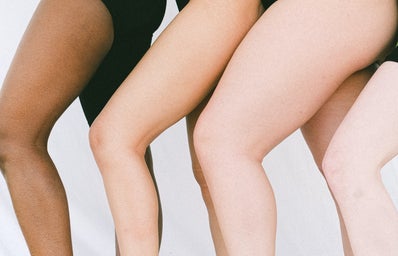Victoria’s Secret is spearheading the most extreme brand makeover by swapping the Victoria’s Secret Angels with seven inspiring women who are famous for their achievements and not their proportions. Say goodbye to the fantasy bra, culturally irrelevant Victoria Secret Fashion Show, or any one-size-fits exclusive. The company has a reputation for embracing unrealistic beauty standards by encouraging women to fall into objectification and hypersexualization. In October 2014, Victoria’s Secret marketing campaign was “The Perfect Body,” which upheld the values of unrealistic, patriarchal beauty standards. Victoria’s Secret was bombarded with backlash and hashtags like #iamperfect in response to their irresponsible message; they changed the advertising to “A Body for Every Body” with no public statement following the negative buzz. Women do not need to be reminded of society’s standards of a homogeneous definition of beauty; the single-lens ad features almost identical body shapes and creates horizontal hostility among the consumers. That idea of “sexy” promotes body dysmorphia, self-consciousness, and low self-esteem to their target audience: young women. Traditionally, Victoria’s Secret has been synonymous with selling male fantasies to men through female bodies. The company was based on the idea that men bought women lingerie so the stores were curated for men’s tastes (i.e., dark-colored clothing, leather couches, racy garments). Now, Victoria’s Secret is rebranding itself to give women what they want. Though the company’s sexist and objectifying advertisement is a relic of the past, should the company be ‘canceled?’
In response to the #MeToo movement and modern activism of gender equality, Victoria’s Secret is ready for a relaunch with an ad campaign attempting to embody “What Women Want.”
They are prepared to evolve to redefine the version of sexy. In August 2021, the lingerie giant introduced a group of victorious women labeled the “VS Collective” which featured Megan Rapinoe (Gender Equity Campaigner, LGBTQ+ Activist, and Soccer Star), Eileen Gu (17-year-old Chinese American freestyle skier), Paolma Elsesser (Biracial, Plus Size Model), Priyanka Chopra Jonas (Indian Actor and Tech Investor), Valentina Sampaio (TransModel), Adut Akech (Model and South Sudanese Refugee) and Amanda de Cadenet (Founder of #Girlgaze). This inspiring group of women collectively expressed that they were not the “typical brand targets.” There will no longer be alienation in ads toward how women should act or look like but instead, there will be women illustrating how to overcome gender barriers to achieve success. The CEO of Victoria’s Secret, Martin Waters, stated that as the world was changing, they were too slow to respond. In the past, a conflict with Chief Marketing Officer, Ed Razek, occurred in 2018 when he claimed that “transexual” models should not be cast in the fashion show because the “show is a fantasy.” He states, “We attempted to do a television special for plus-sizer [in 2000]. No one had any interest in it, still don’t.” Their mission is to stop being about what men what but rather become an inclusive platform for the desire of all identities. The new campaign’s purpose is to resemble the motto “For her, by her.” This marketing will demonstrate that all bodies are beautiful and will be epitomized in the 2022 Victoria Secret Fashion Show; this has been projected to have a “new look” of intersectionalism and feminism.
Is Victoria’s Secret finally becoming more socially aware, or are the company’s motives an attempt to salvage their marketing share and increase profit? Multiple shocks have disrupted the industry of lingerie that potentially encouraged the brand turnaround. For example, though Victoria’s Secret industry standing is strong, its share of women’s underwear dropped to 21% from 32% in 2015. Competitors in the underwear industry (i.e., Skims, Aerie, ThirdLove, Savage x Fenty) have created more inclusive ad campaigns incorporating sexuality, race, and gender. Overall, consolidating socially responsible ideologies of body positivity and self-worth in their messaging. This all-encompassing advertisement from these companies has increased sales and returning customer ratios, however, has posed a setback for Victoria’s Secret. Consumers favor inclusivity, diversity, and growth. It is imperative that a consumer feels comfortable and represented; they want to shop somewhere where they can visualize themselves. Women want comfort and beauty; this Mother’s Day Victoria’s Secret featured its first pregnant model. The goal of this is to create new products that provide comfort and support by incorporating athleisure, maternity wear, nursing, and mastectomy as well as a wide range of sizes up to XXXXXL for all consumers. Currently, Victoria’s Secret carries up to a 42G in bras and XXL in nightwear. In the realm of growth, Victoria’s Secret created a podcast called “VS Voices” hosted by Amanda de Cadenet, featuring members of the VS Collective sharing their stories to elevate women not just by beauty quantified by the male gaze. To this end, the company created a charitable initiative called the VS Global Fund for Women’s Cancer to boost cancer research. This plans to unlock innovations and treatments for the eradication of cancer. Victoria’s Secret is taking a stand for gender equity and wants to make a difference. But, is there room for growth within the company especially with the introduction of new leadership, mission, and values, or has the damage been done?


